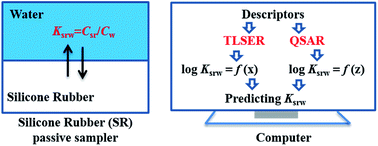Development of predictive models for silicone rubber–water partition coefficients of hydrophobic organic contaminants†
Abstract
The silicone rubber passive sampling technique is extensively applied to monitor the aqueous freely dissolved concentration of hydrophobic organic compounds (HOCs). The silicone rubber–water partition coefficient (Ksrw) is an important parameter to accurately measure the concentrations of chemicals using passive sampling devices. In this study, two theoretical linear solvation energy relationship (TLSER) models and a quantitative structure–property relationship (QSPR) model were developed for predicting the Ksrw of HOCs. The 119 model compounds studied here included 31 personal care products, such as musks, UV-filters, and organophosphate flame retardants, as well as “conventional” pollutants, such as polycyclic aromatic hydrocarbons and polychlorinated biphenyls. The statistical parameters indicated that the final QSPR model with seven descriptors for all 119 chemicals had a satisfactory goodness-of-fit (Radj2 = 0.898), robustness (QLOO2 = 0.881) and predictive ability (Qext-F1,2,32 = 0.897–0.926). In comparison, the results of one TLSER model with four descriptors for 113 chemicals (Radj2 = 0.826, QLOO2 = 0.790, Qext-F1,2,32 = 0.805–0.837) and another TLSER model with one descriptor for 5 chemicals (Radj2 = 0.747, QLOO2 = 0.647) were also acceptable. The applicability domains of the obtained models covered chemicals containing hydroxyl, imino groups, carbonyl groups, ether bonds, halogen atoms, sulfur atoms, phosphorus atoms, nitro groups, and cyano groups. In addition, the structural features governing the partition behavior of chemicals between silicone rubber and water were explored through interpretation of appropriate mechanisms.



 Please wait while we load your content...
Please wait while we load your content...